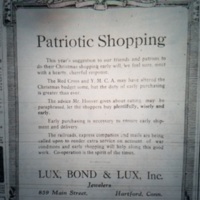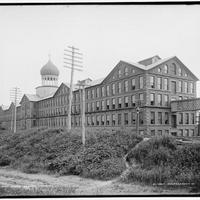Browse Exhibits (11 total)
Connecticut Irish and World War I
A brief history of the Irish American citizens of Connecticut who took up arms and fought for America during World War I.
The Red Cross and Its Nurses in Connecticut during World War I
This exhibit will explore the history of the Red Cross in Connecticut and the role its nurses played in the organization during World War I.
Moving on Up? The Great Migration in Hartford Connecticut during the “Great War”
The Challenges and Triumphs of Hartford's African American Residents During the Decade of the Great War
African Americans in World War I: Contributions, Efforts, and the Fight for Equality
A brief history of the contributions of African Americans during and after World War I: on the front lines, on the home front, coming back from the war, and fighting for equality in a country that enslaved them fifty years before.
Connecticut Manufacturing During the First World War
An overview of manufacturing in Connecticut during the First World War using photos from various factories showcasing their productions.
Hartford Women in World War I
An exhibit of stories of lives of Hartford women during World War I.
The Woman's Land Army of America in World War I
The Woman’s Land Army of America (WLAA) was an organization that began as an effort to alleviate the farm labor and food shortages that the United States was facing during World War I. This organization, formed and run entirely by women, recruited and trained female volunteers to work the fields at a time when male farmhands were scarce. These women, known as farmerettes, made a significant contribution to the war effort and helped to ensure that the American nation and its men fighting in Europe were well fed.
This exhibit explores the activities of the Woman's Land Army of America in World War I.
Advertising the War: How Business Bought In.

During a convention for advertising, speaker Joseph Appel stated, "Advertising is not to sell, but to help people buy...We stand in the shoes of the customer. We are outside, not behind the counter. We are councelors for the public." The Progressive Era, the 1890's through the 1920's, saw a concerted effort to separate ad men from suppliers, and to align them with consumers. This approach had never been done before. Instead of selling a product, they were recommending them. Rather than gear ads for the company, they were made for the sophisticated reader.
Six days after the official American entry into the War to End All Wars, President Woodrow Wilson signed into existence the Committee on Public Information (CPI), also known as the Creel Committee. It consisted of mainly of Mr. Creel, and the Secretaries of State, Navy, and War who were ex-facto members. The Secretaries and had little impact, choosing to allow Mr. Creel mostly carte blanche in his Committee. In his post-war book detailing the CPI claimed that what he was doing was not propaganda. Creel stated that "In no degree was the Committee an agency of censorship, a machinery of concealment or repression. Its emphasis throughout was on the open and the positive. At no point did it seek or exercise authorities under those war laws that limited the freedom of speech and press. In all things, from first to last, without halt or change, it was a plain publicity proposition, a vast enterprise in salesmanship, the world’s greatest adventure in advertising." I will leave it up to viewer if these are propaganda items or not.
Important changes happened in the Great War, little known was how the art of propaganda (if we dare to call it that) subtly increased sales, fostered support for the war and pushed the public to sacrifice. This is a brief pictorial overview of business advertisements in local Connecticut newspapers in the Christmas Holiday season of 1917. The date range was chosen because that time of the year advertisements were more numerous and the troops were finally "Over There". The Advertising the War: How Business Bought In Exhibit will focus on involving readers and customers in the war effort, and in the background necessary to come to their own conclusions.
Firearm Manufacturing in Connecticut during the Great War

This exhibit will explore the role Connecticut factories had in firearm production during the Great War. From companies like the Colt Manufacturing Company in Hartford to Winchester Repeating Arms in New Haven, Connecticut factories were responsible for a significant portion of the United States weapon supply.
Not only did Connecticut factories have a significant impact on the war effort, but urban cities became increasingly industrial during World War I, seeing a drastic increase in the percentage of workers employed in industrial jobs.
The technological innovations in weapons during World War I were beyond anything ever seen in years prior. In Hartford and New Haven, designs for automatic and semi-automatic weapons were being created, and weapons like the Colt Vickers machine gun changed the face of war.
In this exhbit, one will be able to see images of the factories, weapons, and workers that made this historical impact, along with the newspaper articles and advertisements that demonstrate the cultural impact of companies like Colt and Winchester.
Exhibit Created by James Annunziato
